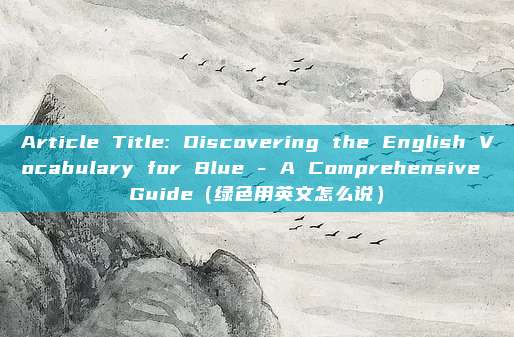Article Title: Discovering the English Vocabulary for Blue - A Comprehensive Guide(绿色用英文怎么说)
温馨提示:这篇文章已超过242天没有更新,请注意相关的内容是否还可用!
Content:
In the vast realm of colors, blue holds a unique position, symbolizing tranquility, depth, and a sense of calm. Whether you're discussing art, fashion, or simply trying to convey an emotion, knowing how to express the color blue in English is essential. In this article, we will delve into the various ways to say "blue" in English, including synonyms, idiomatic expressions, and the cultural nuances that come with it.
The Basic Term: "Blue"
The most straightforward way to refer to the color blue in English is simply by using the word "blue." This term is universally recognized and understood across different English-speaking regions.

Synonyms and Variations
To expand your vocabulary, here are some synonyms and variations of the color blue:
1、Azure: Azure is a bright and cheerful shade of blue, often associated with the clear, sky-high hues of the day.
2、Cerulean: Similar to azure, cerulean is a pale, sky-blue color that is often used to describe a tranquil and serene atmosphere.
3、Cobalt: A deep, rich blue, cobalt is often used in art and fashion to convey a sense of sophistication and depth.
4、Indigo: Indigo is a dark blue color, reminiscent of the dye used in traditional fabrics and often associated with a sense of mystery and elegance.
5、Teal: Teal is a shade of blue-green, often used to describe a more subdued and natural tone.
Idiomatic Expressions Involving Blue
Idioms are a rich part of the English language, and many of them involve the color blue. Here are a few examples:
1、"As blue as the sky": This expression is used to describe something that is very beautiful or perfect, akin to the clear, beautiful sky.
2、"Feel blue": When someone feels blue, it means they are feeling sad or down.
3、"Out of the blue": This phrase is used to describe something that happens unexpectedly, as if out of nowhere.
Cultural Nuances
The color blue also carries different cultural connotations around the world:
- In Western culture, blue is often associated with serenity, trust, and stability.
- In some Eastern cultures, blue can represent youth and immortality.
- In Hinduism, blue is the color of Krishna, a deity associated with compassion and love.
Practical Applications
Understanding how to describe blue in English is not just about expanding your language skills; it's also practical. Here are a few scenarios where knowing different terms for blue can be beneficial:
Fashion: When describing a new outfit or accessory, using specific colors like "cerulean" or "navy" can help convey the exact shade you're referring to.
Design: In graphic design, knowing the correct terminology for different shades of blue can help in accurately conveying the intended mood or theme of a project.
Art: Artists often use specific colors to evoke certain emotions or create a particular atmosphere. Knowing the technical terms for shades of blue can enhance one's ability to communicate these intentions.
Conclusion
The color blue, with its many shades and connotations, is a rich subject in English. By familiarizing yourself with the various ways to express blue in English, you can enhance your communication in a wide range of contexts. Whether you're discussing art, fashion, or simply trying to express an emotion, having a comprehensive understanding of the color blue in English will serve you well.
网站文章、图片来源于网络,以不营利的目的分享经验知识,版权归原作者所有。如有侵权请联系删除!





还没有评论,来说两句吧...